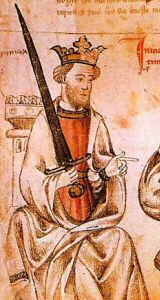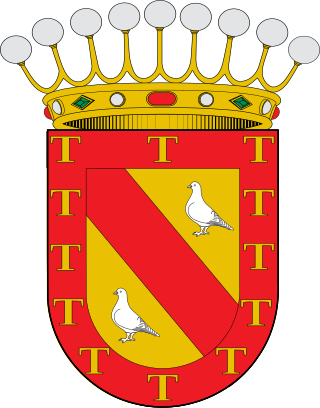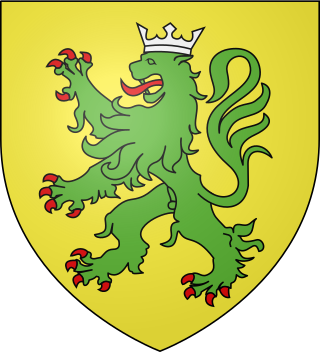
Alfonso IV, called the Kind was King of Aragon and Count of Barcelona from 1327 to his death. His reign saw the incorporation of the County of Urgell, Duchy of Athens, and Duchy of Neopatria into the Crown of Aragon.

The House of Bourbon is a dynasty that originated in the Kingdom of France as a branch of the Capetian dynasty, the royal House of France. Bourbon kings first ruled France and Navarre in the 16th century. A branch descended from the French Bourbons came to rule Spain in the 18th century and is the current Spanish royal family. Further branches, descended from the Spanish Bourbons, held thrones in Naples, Sicily, and Parma. Today, Spain and Luxembourg have monarchs of the House of Bourbon. The royal Bourbons originated in 1272, when Robert, the youngest son of King Louis IX of France, married the heiress of the lordship of Bourbon. The house continued for three centuries as a cadet branch, serving as nobles under the direct Capetian and Valois kings.

Sancho IV of Castile called the Brave, was the king of Castile, León and Galicia from 1284 to his death. Following his brother Ferdinand's death, he gained the support of nobles who declared him king instead of Ferdinand's son Alfonso. Faced with revolts throughout his reign, before he died he made his wife regent for his son, who became Ferdinand IV.

James II, called the Just, was the King of Aragon and Valencia and Count of Barcelona from 1291 to 1327. He was also the King of Sicily from 1285 to 1295 and the King of Majorca from 1291 to 1298. From 1297 he was nominally the King of Sardinia and Corsica, but he only acquired the island of Sardinia by conquest in 1324. His full title for the last three decades of his reign was "James, by the grace of God, king of Aragon, Valencia, Sardinia and Corsica, and count of Barcelona".

Don Juan Manuel was a Spanish medieval writer, nephew of Alfonso X of Castile, son of Manuel of Castile and Beatrice of Savoy. He inherited from his father the great Lordship of Villena, receiving the titles of Lord, Duke and lastly Prince of Villena. He married three times, choosing his wives for political and economic convenience, and worked to match his children with partners associated with royalty. Juan Manuel became one of the richest and most powerful men of his time, coining his own currency as the kings did. During his life, he was criticised for choosing literature as his vocation, an activity thought inferior for a nobleman of such prestige.

The House of Rohan is a Breton family of viscounts, later dukes and princes in the French nobility, coming from the locality of Rohan in Brittany. Their line descends from the viscounts of Porhoët and is said to trace back to the legendary Conan Meriadoc. Through the Porhoët family, the Rohans are related to the Dukes of Brittany, with whom the family intermingled again after its inception. During the Middle Ages, it was one of the most powerful families in the Duchy of Brittany. The Rohans developed ties with the French and English royal houses as well, and they played an important role in French and European history.

Charles II, called the Magnanimous was Count of Alençon and Count of Perche (1325–1346), as well as Count of Chartres and Count of Joigny (1335–1336) as husband of Joan of Joigny.

Alfonso of León, Lord of Molina was an infante (prince) of León and Castile, the son of King Alfonso IX of León and his second wife Queen Berengaria of Castile. He was the brother of King Ferdinand III of Castile and León, and father of Queen Maria of Molina, wife of King Sancho IV. He became Lord of Molina and Mesa after his first marriage to Mafalda González de Lara, the heiress of those lands.

Charles de la Cerda, commonly known as Charles of Spain, was a Franco-Castilian nobleman and soldier, the son of Alfonso de la Cerda of Spain and Isabelle d'Antoing, and grandson of Alfonso de la Cerda the disinherited (1270–1333). He was a distant cousin of John II of France.

María Alfonso Téllez de Meneses, known as María de Molina, was queen consort of Castile and León from 1284 to 1295 by marriage to Sancho IV of Castile, and served as regent for her minor son Ferdinand IV and later her grandson Alfonso XI of Castile (1312-1321).

Violant or Violante of Aragon, also known as Yolanda of Aragon, was Queen consort of Castile and León from 1252 to 1284 as the wife of King Alfonso X of Castile.

Fernando de la Cerda (1275–1322) was the younger son of Ferdinand de la Cerda, Infante of Castile and his wife Blanche of France. His paternal grandparents were Alfonso X of Castile and Violant of Aragon. His maternal grandparents were Louis IX of France and Marguerite of Provence. His elder brother was Alfonso de la Cerda.

Alfonso de la Cerda,, called "the Disinherited", was the elder son of Ferdinand de la Cerda and his wife Blanche of France, and was a grandson of Alfonso X of Castile. Alfonso and his brother Fernando were candidates for the Castilian-Leonese crown during the reigns of Sancho IV of Castile, Ferdinand IV of Castile and Alfonso XI of Castile. In 1331, Alfonso renounced his rights and swore allegiance to Alfonso XI of Castile.

Luis de La Cerda, also called Louis of Spain was an expatriate royal prince of the Crown of Castile, who lived and served in the Kingdom of France. Among his titles, Luis de la Cerda was the count of Talmont, count of Clermont and an admiral of France. He was also made the first 'Prince of Fortuna' by Pope Clement VI in 1344, although he never actually set foot on the islands.

Juan III Núñez de Lara y de la Cerda, Lord of Lara and Vizcaya, son of Ferdinand de la Cerda (1275–1322) and Juana Núñez de Lara the Little Dove. Despite belonging to the House de la Cerda and aspiring to the Castilian-Leonese throne during the reigns of Sancho IV of Castile, Ferdinand IV of Castile and Alfonso XI of Castile, he carried the family name of his mother which corresponded to the name of his lordship.

Peter of Castile, was an infante of Castile. He was a son of Alfonso X of Castile and Violant of Aragon who was also called Yolanda or Yolante.

Philip of Castile, was an infante of Castile, son of Sancho IV of Castile and María de Molina.

Juan Núñez I de Lara y León, also known as "el Gordo" or "the Fat", was a Spanish noble. He was the head of the House of Lara, Lord of Lerma, Amaya, Dueñas, Palenzuela, Tordehumos, Torrelobatón, and la Mota. He was further known as Señor de Albarracín through his first marriage with Teresa Álvarez de Azagra.

Coloma or de Coloma or Colomba is an old important Spanish Noble House. A branch belongs to the Flemish nobility, and became the Counts of Bornhem. Other branches became the Counts of Elda, Marquesses of Espinar, Marquesses of Noguera and Marquesses of Canales de Chozas.

Robert VIII Bertrand de Bricquebec, also known as Robert Bertrand, Baron of Bricquebec, Viscount of Roncheville, was a 14th century Norman noble. He served as Marshal of France from 1325 until 1344.


















